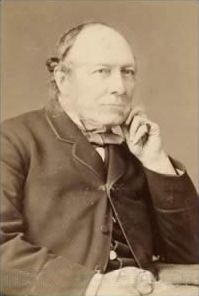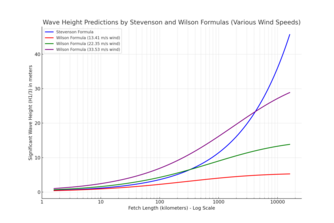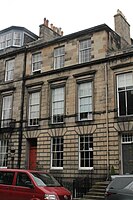Thomas Stevenson
 From Wikipedia - Reading time: 12 min
From Wikipedia - Reading time: 12 min
Thomas Stevenson | |
|---|---|
 Stevenson in 1880 | |
| Born | 22 July 1818 Edinburgh, Scotland |
| Died | 8 May 1887 (aged 68) Edinburgh, Scotland |
| Occupation | Lighthouse engineer |
| Employer | Northern Lighthouse Board |
| Spouse |
Maggie Balfour (m. 1848) |
| Children | Robert Louis Stevenson |
| Parent(s) | Robert Stevenson (father) Jean Smith (mother) |
| Relatives | David Stevenson (brother) Alan Stevenson (brother) |
| Signature | |
Thomas Stevenson PRSE MInstCE FRSSA FSAScot (22 July 1818 – 8 May 1887) was a pioneering Scottish civil engineer, lighthouse designer and meteorologist, who designed over thirty lighthouses in and around Scotland, as well as the Stevenson screen used in meteorology. His designs, celebrated as ground breaking, ushered in a new era of lighthouse creation.
He served as president of the Royal Scottish Society of Arts (1859–60), as president of the Royal Society of Edinburgh (1884–86), and was a co-founder of the Scottish Meteorological Society.[1]
He was the father of writer Robert Louis Stevenson.
Life and career
[edit]He was born at 2 Baxters Place[2] in Edinburgh, on 22 July 1818, the youngest son of engineer Robert Stevenson, and his wife (and step-sister) Jean Smith. He was educated at the Royal High School in Edinburgh.
Thomas Stevenson was a devout and regular attendee at St. Stephen's Church in Stockbridge, at the north end of St Vincent Street, Edinburgh.
He lived with his family at Baxters Place until he got married in 1848. He then got a house at 8 Howard Place.[3] By 1855 he moved to 1 Inverleith Terrace.[4] From at least 1860 he lived at 17 Heriot Row, a large Georgian terraced townhouse in Edinburgh's New Town.[5]
In 1864, he published The design and construction of harbours: a treatise on maritime engineering. The book was based on an article he had originally written for the Encyclopædia Britannica, and covered the principles and practices involved in harbour design and construction. The work discussed the geological and physical features affecting harbour design, the generation and impact of waves, along with construction materials and masonry types for quay walls. The book also explored the efficacy of tides and fresh water in maintaining outfalls. A second edition of the book was published in 1874.[6]
In 1869, as a successful experiment into using the newly invented electric light for lighthouses, Stevenson had an underwater cable installed from the eastern part of Granton Harbour, and a light on the end of the Trinity Chain Pier was controlled from half a mile away by an operator on the harbour.[7][8] He designed the Stevenson screen as a shelter to shield meteorological instruments, and this has been widely adopted.
He died at 17 Heriot Row in Edinburgh on 8 May 1887 and is buried in the Stevenson family vault in New Calton Cemetery. The vault lies midway along the eastern wall.
Stevenson's formula for the prediction of wave heights
[edit]In the course of his work as a lighthouse and harbour engineer, Stevenson had made observations of wave heights at various locations in Scotland over a number of years. In 1852, he published a paper in which he suggested that waves increased in height by a ratio approximate to the square root of their distance from the windward shore.[9] Stevenson developed this into the simple formula , in which is the wave height in feet and is the fetch in miles.[10]
Essential components for wave height prediction, most notably wind speed, are missing from Stevenson's formula. In 1852, mathematical analysis of the theory of water waves, and methods for numerical assessment of factors such as shoaling and surge, were in their infancy.[11][12] Stevenson's analysis[13] is possibly the first quantitative discussion of wave height as a (square root) function of fetch, and his paper[14] is one of the first quantitative studies of wind speeds in the planetary boundary layer.
Modern analysis of Stevenson's formula indicates that it appears to conservatively estimate wave heights for wind speeds up to around 30 miles per hour, being based on his observations which most likely were taken for fetch lengths under 100 kilometres, without fully developed seas. The breakwater at Wick was exposed to a fetch length of approximately 500 kilometres, and wind speeds far in excess of 30 miles per hour, prior to its eventual destruction.[10][15]
In 1965, the South African engineer Basil Wrigley Wilson proposed a method which can be used to approximate the significant wave height H1/3 and period T1/3 of wind waves generated by a constant wind of speed U blowing over a fetch length F.[16] The units for these quantities are as follows:
- H1/3 in metres (m)
- T1/3 in seconds (s)
- U in metres per second (m/s)
- F in metres (m)
Wilson's formulae apply when the duration of the wind blowing is sufficiently long, as when the wind blows for only a limited time, waves cannot attain the full height and period corresponding to the wind speed and fetch length.[17] Under conditions were the wind blows for a sufficiently long time, for example during a prolonged storm, the wave height and period can be calculated as follows:
In these formulae, g denotes the acceleration due to gravity, which is approximately 9.807 m/s2. The wind speed U is measured at an elevation of 10 metres above the sea surface. For conditions approximate to those for the Wick breakwater during a storm (fetch length of 500km, wind speed of around 75mph), the graph below shows that Wilson's method predicts a significant wave height (H1/3) of around 1.5 times that of Stevenson's.[9][16]

Nonetheless, whilst Stevenson's formula is highly limited and unsuitable for engineering design application, it was notable for being an early attempt to apply mathematical theory to hydraulic engineering problems, and shows some limited agreement (albeit within a narrow range) with a more advanced formula developed by Ramón Iribarren in 1942.[15][18] A major flaw in Stevenson's formula is the absence of consideration of wind speed, and comparison with Wilson's formula at 3 different wind speeds (30, 50 and 75mph) shows only a reasonable level of agreement for 50mph winds at fetch lengths up to around 100 metres.[9][16]

Stevenson himself noted that the formula was an approximation,[19] and actively encouraged further research into similar problems, imploring young engineers to redouble efforts in the advancement of coastal engineering during an 1885 address to the Institution of Civil Engineers in London.[20] In addition to his work on wave growth, he also undertook research into the phenomenon of wave decay inside harbour basins.[21]
The breakwater at Wick, Caithness
[edit]Stevenson designed and supervised the construction of a breakwater at Wick in 1863, which at the time was the largest herring fishery in Europe. The inner harbour, designed by Thomas Telford, was completed in 1811, followed by the construction of the expanded outer harbour by James Bremner between 1825 and 1834. However, by 1857, the need for increased capacity became evident, leading the British Fishery Society to propose a new breakwater. In 1862 Stevenson, along with his brother David, prepared detailed plans, sections, and specifications for the harbour's extension. This design received support from Sir John Coode and John Hawkshaw. A loan of £62,000 was sanctioned by A. M. Rendel, the engineer for the Public Works Loan Commission.[22]
Construction commenced in April 1863, aiming for a final length of 460 metres. Stevenson's design featured a rubble mound extending to 5.5 metres above the low water mark, following the Crane Rocks. This was capped with block walls and in-filled with rubble, providing a superstructure up to 16 metres wide. The rubble for the mound was sourced from local quarries and transported by steam locomotives. This was then deposited onto the breakwater mound using travelling gantries that ran along the staging, marking a possible first in Scotland for this technique.[23][22] The seaward wall was constructed with a 6:1 batter. Below the waterline, the blocks were dry-jointed, whereas above the high-water mark, initially Roman and later Portland cement mortar was used.[24]
The breakwater failed progressively as a result of several storms, and by 1870 it had lost one third of its length. It was eventually abandoned in 1877, after further severe storm damage, despite repeated failed attempts at its reconstruction.[15][22][24] Stevenson noted, in correspondence with the Institution of Civil Engineers, that a single storm had at one stage removed 1,350 tonnes of material from the breakwater, but he was unable to provide the height of the waves during the event.[25]
Applying present-day techniques to calculate local wave conditions demonstrates that the breakwater as built would not have survived without mobilising additional restraint, or a mechanism to abate wave forces.[24] Stevenson's own wave formula would have predicted offshore wave heights for Wick of around 8 to 10 metres, whereas modern observations show that the North Sea exhibits wave heights of up to two to three times this figure.[26][27][28][10]
Family
[edit]He was brother of the lighthouse engineers Alan and David Stevenson, between 1854 and 1886 he designed many lighthouses, with his brother David, and then with David's son David Alan Stevenson.
He married Margaret Isabella "Maggie" Balfour in 1848, daughter of Rev Lewis Balfour. Their son was the writer Robert Louis Stevenson, who initially caused him much disappointment by failing to follow the engineering interests of his family.
His wife's younger brother, James Melville Balfour (i.e. his brother-in-law), trained under D. & T. Stevenson and then emigrated to New Zealand, where he was first the marine engineer for Otago Province before he was appointed Colonial Marine Engineer.[29][30]
Lighthouses designed by Thomas Stevenson
[edit]- Whalsay Skerries (1854)
- Out Skerries (1854)
- Muckle Flugga (1854)
- Davaar (1854)
- Ushenish (1857)
- South Rona (1857)
- Kyleakin (1857)
- Ornsay (1857)
- Sound of Mull (1857)
- Cantick Head (1858)
- Bressay (1858)
- Ruvaal (1859)
- Corran Point (1860)
- Fladda (1860)
- McArthur's Head (1861)
- St Abb's Head (1862)
- Butt of Lewis (1862)
- Holborn Head (1862)
- Monach Islands (1864)
- Skervuile (1865)
- Auskerry (1866)
- Lochindaal (1869)
- Scurdie Ness (1870)
- Stour Head (1870)
- Dubh Artach (1872)
- Turnberry Point (1873)
- Chicken Rock (1875)
- Lindisfarne (1877, 1880)
- Fidra (1885)
- Oxcar (1886)
- Ailsa Craig Lighthouse (1886)
Gallery
[edit]-
Townhouse at 17 Heriot Row, Edinburgh
-
Condensing light. Lighthouse optic, designed by Thomas Stevenson. Chance Brothers and Company, Birmingham, 1866. National Museum of Scotland, Edinburgh
-
Thomas Stevenson by Sir George Reid, 1878
See also
[edit]- Richard Henry Brunton, "father of Japanese lighthouses"
- John Richardson Wigham, Irish inventor and lighthouse engineer
References
[edit]- ^ Waterston, Charles D; Macmillan Shearer, A (July 2006). Former Fellows of the Royal Society of Edinburgh 1783-2002: Biographical Index (PDF). Vol. II. Edinburgh: The Royal Society of Edinburgh. ISBN 978-0-902198-84-5. Archived from the original (PDF) on 4 October 2006. Retrieved 31 December 2010.
- ^ Edinburgh Post Office Directory 1818
- ^ Edinburgh Post Office Directory 1850
- ^ Edinburgh Post Office directory 1855
- ^ Edinburgh Post Office Directory 1860
- ^ Stevenson, T. (1874). The Design and Construction of Harbours: A Treatise on Maritime Engineering (2nd ed.). Edinburgh: Adam & Charles Black. doi:10.1017/cbo9780511997020. ISBN 978-1-108-02967-4. Retrieved 12 January 2024.
- ^ The Nautical Magazine and Naval Chronicle for 1869. Cambridge Library Collection. 28 March 2013. pp. 614–615.
- ^ Stevenson, Thomas (9 April 2009). Lighthouse Construction and Illumination. BiblioBazaar. pp. 165–166. ISBN 978-1103900954.
- ^ a b c Stevenson, T. (1852). "Observations on the relation between the height of waves and their distance from the windward shore". Edinburgh New (Jameson's) Philosophical Journal. 53: 358–359.
- ^ a b c Stevenson, T.; Townson, J.; Wilson, W. (1981). "The Stevenson Formula for Predicting Wave Height: Technical Note". Proceedings of the Institution of Civil Engineers. 71 (3): 907–909. doi:10.1680/iicep.1981.1826. ISSN 1753-7789. Retrieved 28 July 2023.
- ^ Goda, Y. (1999). 「波動問題」の歴史的変遷 [On the Historical Development of the Mathematical Theory of Water Waves] (PDF) (in Japanese). Tokyo: Japan Society of Civil Engineers. Retrieved 12 January 2024.
- ^ Goda, Y. (1999). "On the Historical Development of the Mathematical Theory of Water Waves". 35th Summer Training Course Lecture Collection, Japan Society of Civil Engineers Coastal Engineering Committee. Translated by McParland, D. Retrieved 12 January 2024 – via TU Delft Repository.
- ^ Stevenson, T. The Design and Construction of Harbors: A Treatise on Maritime Engineering, seconded. Adam and Charles Black, Edinburgh
- ^ Stevenson, T. (1880) Report on Simultaneous Observations of the Force of Wind at Different Heights above the Ground, Journal of the Scottish Meteorological Society, LI-LIV, pp. 103–107
- ^ a b c Townson, J.M.; Wilson, B.W. (1982). "Discussion: The Stevenson Formula for Predicting Wave Height". Proceedings of the Institution of Civil Engineers. 73 (2): 485–487. doi:10.1680/iicep.1982.1716. ISSN 1753-7789. Retrieved 28 July 2023.
- ^ a b c Wilson, B.W. (1965). "Numerical prediction of ocean waves in the North Atlantic for December, 1959". Deutsche Hydrographische Zeitschrift. 18 (3): 114–130. Bibcode:1965DeHyZ..18..114W. doi:10.1007/BF02333333. ISSN 0012-0308. Retrieved 29 July 2023.
- ^ Goda, Y. (2003). "Revisiting Wilson's Formulas for Simplified Wind-Wave Prediction". Journal of Waterway, Port, Coastal, and Ocean Engineering. 129 (2): 93–95. doi:10.1061/(ASCE)0733-950X(2003)129:2(93). ISSN 0733-950X. Retrieved 30 July 2023.
- ^ Iribarren, R. (October 1942). "Wave action in relation to harbour protection works". Journal of the Dock and Harbour Authority.
- ^ Stevenson, T. (1885). The theory and practice of hydromechanics. London: Thomas Telford Publishing. doi:10.1680/tapoh.45217.0005. ISBN 978-0-7277-4521-7. Retrieved 28 July 2023.
- ^ "Obituary: Thomas Stevenson (1818-1887)". Minutes of the Proceedings of the Institution of Civil Engineers. 91 (1888): 424–426. 1888. doi:10.1680/imotp.1888.20990. ISSN 1753-7843.
- ^ Ortt, F.L. (1895). Een veilige buitenduinsche haven voor Scheveningen [A safe outer-dune harbour for Scheveningen] (in Dutch). M. Nijhoff. Retrieved 11 August 2023.
- ^ a b c Paxton, R. (2010). "The Sea versus Wick Breakwater 1863-77 — an instructive disaster". In Allsop, W. (ed.). The Sea versus Wick Breakwater 1863-77: An instructive disaster, in Coasts, marine structures and breakwaters: Adapting to change: Proceedings of the 9th international conference organised by the Institution of Civil Engineers and held in Edinburgh on 16 to 18 September 2009. London: Thomas Telford Ltd. pp. 31–42. doi:10.1680/cmsb.41301.0003. ISBN 978-0-7277-4159-2. Retrieved 28 July 2023.
{{cite book}}: CS1 maint: date and year (link) - ^ Paxton, R.; Shipway, J., eds. (2007). Civil Engineering Heritage Scotland – Highlands and Islands. Thomas Telford Publishing. pp. 31–42. doi:10.1680/cehs.34884.0004. ISBN 978-0-7277-3729-8. Retrieved 13 January 2024.
- ^ a b c Allsop, N.W.H.; Bruce, T. (2019). "Failure analysis of historic vertical breakwaters, part 1: Wick". Proceedings of the Institution of Civil Engineers - Forensic Engineering. 172 (2): 43–53. doi:10.1680/jfoen.20.00002. ISSN 2043-9903. S2CID 226861229. Retrieved 28 July 2023.
- ^ Cay, W.D.; Corthell, E.L.; Eliot, W.; Heenan, R.H.H.; Jarrad, F.W.; Neate, C.; Olive, W.T.; Siccama, H.T.H.; Waldron, F.W.; Methven, C.W. (1906). "Correspondence on The Harbours of South Africa, with Special Reference to the Causes and Treatment of Sand Bars". Minutes of the Proceedings of the Institution of Civil Engineers. 166 (1906): 69. doi:10.1680/imotp.1906.16709. ISSN 1753-7843. Retrieved 29 July 2023.
- ^ Stanton, B.R. (1984). "Return wave heights off South Uist estimated from seven years of data" (PDF). Institute of Oceanographic Sciences, Report No. 164. 164. Retrieved 13 January 2024 – via NERC Open Research Archive.
- ^ Neill, S.P.; Vögler, A.; Goward-Brown, A.J.; Baston, S.; Lewis, M.J.; Gillibrand, P.A.; Waldman, S.; Woolf, D.K. (2017). "The wave and tidal resource of Scotland". Renewable Energy. 114: 3–17. doi:10.1016/j.renene.2017.03.027.
- ^ Huthnance, J. (1991). "Physical oceanography of the North Sea". Ocean and Shoreline Management. 16 (3–4): 199–231. Bibcode:1991OSM....16..199H. doi:10.1016/0951-8312(91)90005-M. Retrieved 28 July 2023.
- ^ "The Late Mr Balfour". The Star. No. 503. 29 December 1869. p. 3. Retrieved 4 January 2015.
- ^ Beaglehole, Helen (9 July 2013). "Lighthouses - A national system". Te Ara: The Encyclopedia of New Zealand. Retrieved 4 January 2015.
 KSF
KSF


![{\displaystyle gH_{1/3}/U^{2}=0.30\left\{1-\left[1+0.004\left(gF/U^{2}\right)^{1/2}\right]^{-2}\right\}}](https://wikimedia.org/api/rest_v1/media/math/render/svg/bb82345ee09c3b8958dd956aa493ffceaee10b6d)
![{\displaystyle gT_{1/3}/(2\pi U)=1.37\left\{1-\left[1+0.008\left(gF/U^{2}\right)^{1/3}\right]^{-5}\right\}}](https://wikimedia.org/api/rest_v1/media/math/render/svg/f5fd4349324054aeec67e3e1717987d6473dffb3)


